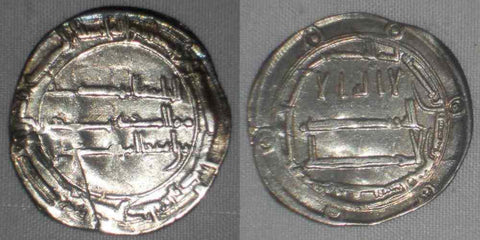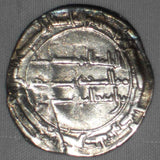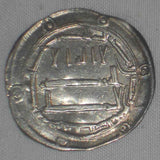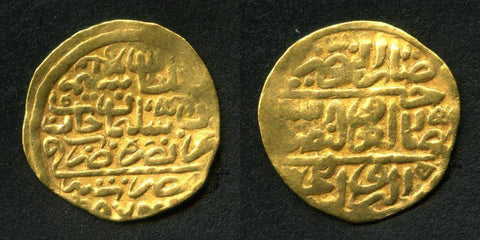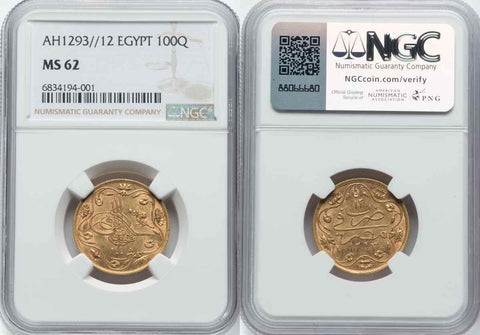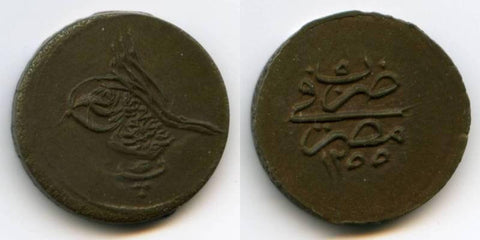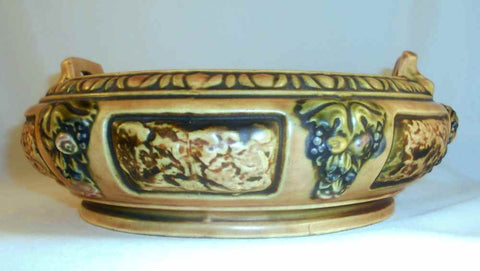Islamic Coin Ifriqiya Abbasid Silver Dirham al-Mahdi Harun al-Rashid Heir 165 AH
Description: Silver Dirham from Al-Mahdi, who ruled the Muslim empire in the period 158-169 AH (775 - 785 AD). Al-Mahdi the third caliph of the Abbasid dynasty. His full name being Abu Abdul Allah al-Mahdi. This is a dirham, weighs ~2.8 grams and is ~23 mm in diameter. The coin shows the date of minting as 165 AH and the mint as Ifriqiya or Northern Africa believed to be in current day Tunis. The obverse of the coin has the words "al-Khalifa al-Mahdi; Mema Amr Beh Harun; Ben Amir al-Mu'minin" in the center and along the edge the verse "Muhammad Rasul Allah, arsaluh bil huda wa din al haq liazharuh 'al al din kulh walaw karah al mushrikon". The reverse shows the name of the mint and the date in a circle along the edge. It also has the words "La Illaha ella Allah, Wahduh la Sharik Lah" in the center. Please note the coin is better than the photos suggest with still fairly legible calligraphy. A nice example of this scarce coin. Please carefully review the images presented as they part and parcel of our description.
Date: 165 AH or 782 AD.
Mint: Ifriqiya or Northern Africa (Tunisia).
Size and weight: This is a dirham weighs ~2.8 grams and is ~23 mm in diameter.
References: It is Album #215.1, and listed in Al'Ush Catalog of Islamic coins preserved in the national museum of Qatar as #1502. It is also listed in Wilkes as 379.
Condition: I would grade this coin as very fine. The coin has readable calligraphy with some discoloration along the edges on both sides. The coin has a wavy flan and shows the mark from a cracked die on the obverse starting at 6:00 O'clock. It also has a few scratches and minor bag marks in the field and shows wear to the high points, but has no losses. Be that as it may, this is a scarce coin, is very nice, and would make a great addition to your collection. Please note the coin itself is better than the photos show with defined and legible calligraphy. Please see scan for additional condition information.
Historic Perspective: Abbasid is an Arabic ruling dynasty, originally based in Madinat al-Salam (current day Baghdad) that expanded the Muslim empire and lasted from 750 Ad to 1258 AD. It was named for al-Abbas (566?-652), paternal uncle of the prophet Muhammad. ). Al-Safah leaded the revolt against the Umayyad established and became the first Abbasid Caliph upon the overthrow of the Umayyad caliph in 132 AH / 749 AD. During the first century of the Abbasid rule the empire experienced a time of unprecedented cultural, artistic and economic development, particularly during the reigns of Harun al-Rashid (786-809) and his son al-Ma’mun (813-833).
Date: 165 AH or 782 AD.
Mint: Ifriqiya or Northern Africa (Tunisia).
Size and weight: This is a dirham weighs ~2.8 grams and is ~23 mm in diameter.
References: It is Album #215.1, and listed in Al'Ush Catalog of Islamic coins preserved in the national museum of Qatar as #1502. It is also listed in Wilkes as 379.
Condition: I would grade this coin as very fine. The coin has readable calligraphy with some discoloration along the edges on both sides. The coin has a wavy flan and shows the mark from a cracked die on the obverse starting at 6:00 O'clock. It also has a few scratches and minor bag marks in the field and shows wear to the high points, but has no losses. Be that as it may, this is a scarce coin, is very nice, and would make a great addition to your collection. Please note the coin itself is better than the photos show with defined and legible calligraphy. Please see scan for additional condition information.
Historic Perspective: Abbasid is an Arabic ruling dynasty, originally based in Madinat al-Salam (current day Baghdad) that expanded the Muslim empire and lasted from 750 Ad to 1258 AD. It was named for al-Abbas (566?-652), paternal uncle of the prophet Muhammad. ). Al-Safah leaded the revolt against the Umayyad established and became the first Abbasid Caliph upon the overthrow of the Umayyad caliph in 132 AH / 749 AD. During the first century of the Abbasid rule the empire experienced a time of unprecedented cultural, artistic and economic development, particularly during the reigns of Harun al-Rashid (786-809) and his son al-Ma’mun (813-833).

